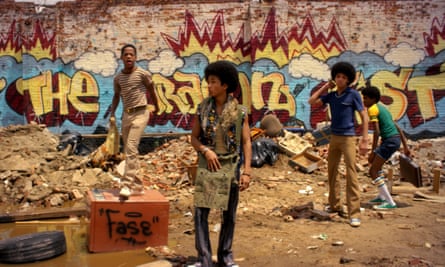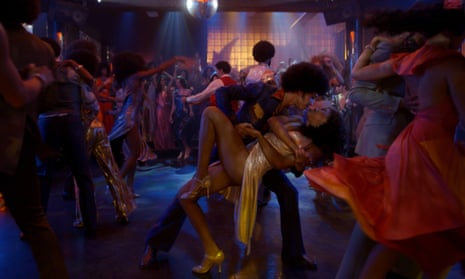The “get down” of The Get Down (Netflix), Baz Luhrmann’s insanely extravagant first foray into television, refers to the essential rhythm part of a record. As opposed to the violins and singing and all that bullshit, which is the “wack”.
Get down is extracted and distilled, using two turntables and wizardry (actually a purple crayon, it turns out), by a wizard (Grandmaster Flash in this instance) and looped ad infinitum, or at least until dawn. The beat goes on. On to which the story is laid down by a wordsmith, the master of ceremonies. And so, hip-hop was born.
This is what Luhrmann has done with a time and a place – the South Bronx, 1977. Attempted to extract the essence, then laid down his story about ambition and a bunch of kids figuring life out. So essence here isn’t just about the rhythm and the music, it’s about the look, the feel, the danger, ganglands and warlords, a bit of politics, a lot of graffiti, which is then reproduced, copied, repeated, looped, embellished, mixed, the real with the half-real with the not-so-real.
The South Bronx 1977 resembles Aleppo 2016, though its desolation is caused by cluster bombs of political neglect, corruption, crime and poverty. From the rubble a new sound emerges. Over in that direction DJ Kool Herc is beginning to do his thing; that way belongs to Afrika Bambaataa. Right here, in the middle, there’s room for something else. Two aspiring musicians, Shaolin Fantastic and Ezekiel Figuero, set off in search of the get down - real, metaphorical, every kind of get down there is.
Disciples of Grandmaster Flash (associate producer of the show), they will become not the Furious Five but The Fantastic Four Plus One and, if it all goes to plan, take over the world. Intense Shao needs to ease back on the day jobs (coke dealer and graffiti artist). And talented but tormented poet Zeke must grow a pair, get off his lazy ass, and get over his (not entirely) unrequited love for sweet, wannabe disco queen, Mylene Cruz.

Hey, this is Baz Luhrmann, what do you expect? Of course there’s going to be a schmaltzy story of young love going on somewhere in there, plus inevitable rooftop stargazing, extravagant high camp and big cheese, etc.
The Get Down looks – and sounds – amazing (you’d hope so, at a reported $10m an episode). Of course, Baz gives good scene and score, like in the downtown Studio 54-ish club in the opening episode – full of brilliant dance routines and seductive, pulsing, funky disco beats. And then the more fly secret underground party in the Bronx - two turntables, no mirrorballs. You’re straight back there, even if you were never there in the first place.
I don’t doubt its authenticity – from the language to the hair and makeup to Shao’s pristine red suede Pumas. Musically too, you only need to look at the credits – with input not just from Grandmaster Flash but also from Nas and legendary music writer Nelson George – to know that Luhrmann’s going to have got a lot of things right. As a love letter to New York in the 70s it is heartfelt, touching, genuine.

Plus there are some brilliant and refreshing performances from a cast that is largely unknown and totally unwhite. Justice Smith, as Zeke, gets more mesmerising as it goes on. There’s a but coming, maybe you guessed. A big but.
BUT… what a mess. The Get Down is a meandering, rubble-strewn sprawl – appropriate you could say, given the setting. But – also appropriate maybe, and given that it’s the way a lot of these kids are – it has very little direction, purpose, drive, momentum. There’s too much going on for any of it to matter very much. A Netflix binge this isn’t. After the extended first episode, I needed a break. I have now done two more episodes, and I’m still not into the groove. Nine more is feeling like a lot ...
There is also an authenticity issue that I have a problem with, to do with subject and style.
Hip-hop is raw and real. But The Get Down is neither of those things. Even if Shao’s red Pumas fit, I’m not convinced that Luhrmann’s extravagance, the sentimentality and overblown grandiosity, the caricatures and cartoonish violence, do. In other words, ironically, it fails to do what Shao and Zeke manage: to isolate and extract the get down.
Way too much wack.

Comments (…)
Sign in or create your Guardian account to join the discussion